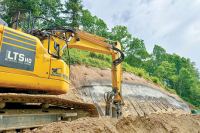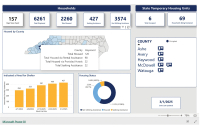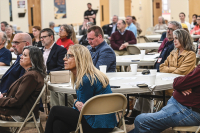Plans for safe passage: Research yields recommendations to stem wildlife deaths on I-40
 Symbolic of the risk–reward situation that bears must face when there is a critical need for them to search for food, security, dispersal or breeding, a female bear looks for the best opportunity to cross as her cubs surround her at the guardrail on I-64 in Virginia near the top of Afton Mountain where the Shenandoah National Park and the Blue Ridge Parkway meet. Bridget Donaldson, Virginia Transportation Research Council photo
Symbolic of the risk–reward situation that bears must face when there is a critical need for them to search for food, security, dispersal or breeding, a female bear looks for the best opportunity to cross as her cubs surround her at the guardrail on I-64 in Virginia near the top of Afton Mountain where the Shenandoah National Park and the Blue Ridge Parkway meet. Bridget Donaldson, Virginia Transportation Research Council photo
After more than three years of research and analysis, a group focused on ending wildlife-vehicle collisions in the Pigeon River Gorge has released a report outlining its recommendations for keeping them safe from traffic.
“Here is a document that serves as long-term planning document for both the Tennessee and North Carolina Department of Transportation, and thankfully they’re both fully engaged and energized by this work,” said Jeff Hunter, senior program manager for the National Parks Conservation Association. “Can we do everything? Can you do everything in any endeavor? Perhaps not, but at least now we have an evidence-based approach to mitigating wildlife-vehicle collisions in this nationally significant landscape adjacent to the Great Smoky Mountains National Park.”
The recommendations released last week were the result of research funded by Safe Passage: The I-40 Pigeon River Gorge Wildlife Crossing Project and completed by NCPA and Wildlands Network. The 86-page report explains the results of the multi-faceted research effort required to understand how many animals are dying during road crossings, where those crossings are occurring and how existing road structures correlate to success in safely navigating the gorge. The research focuses on large animals — specifically bear, deer and elk — because they are easiest to study and pose the most danger to human motorists.
The research
The research area is a 28-mile portion of Interstate 40 that parallels the Pigeon River and is often bordered by sheer rock walls on the opposite side. The entire area is a wildlife hotspot, with the road cutting through an otherwise remote region that’s home to the Great Smoky Mountains National Park, Pisgah National Forest and Cherokee National Forest.
To find out how wildlife use the area, researchers set up a series of camera traps. They established 66 wildlife cameras to monitor 33 400-meter road segments — choosing only segments that did not contain a continuous cut rock cliff — and also set up cameras at 21 roadway structures such as bridges and culverts. Additionally, they fit 13 elk with GPS collars to better understand their movement patterns.
Meanwhile, they sought to understand the magnitude of the wildlife mortality problem. To do this, they compiled information about wildlife deaths contained in crash report data for 2001-2020. Then from September 2018 through December 2021, researchers conducted weekly driving surveys to augment numbers obtained through crash data.
Related Items
Over the 20-year period, researchers recorded 336 incidents of wildlife-vehicle collisions, and all indications are that this is an undercount. In 2020, for example, researchers documented 50 wildlife-vehicle collisions — but only one of those was reflected in agency crash reports.
“We could talk about numbers all day,” said Hunter. “The fact of the matter is we know we have a problem.”
Of the 336 dead animals, 304 records contained enough information for further analysis. Of the 304, the largest number — 55% — were bear, this despite the fact that deer was the most-recorded species on the 66 roadside cameras, accounting for 78% of sightings. Of the cameras set up at the 21 road structures, 86% detected one or more of the target species, with 76% detecting deer, 67% bear and 19% elk.
“I think one of the really interesting findings is that a lot of our mortality is associated with the existing structures,” said Hunter. “It was somewhat counterintuitive until we started peeling back the layers.”
The data showed that the probability of an animal getting hit on the road was higher — not lower — when closer to road structures like bridges and culverts that researchers thought they could potentially be using to help them cross more safely. The researchers surmised this was because road structures tend to be built in places where the grade is a little gentler or the landscape a little more open.
“That’s where the highway engineers built their interchanges, at the path of least resistance where it was easier to engineer these things, and so the wildlife are competing for the same places where our roads are, because that’s where the least-cost path is,” said Hunter.
The researchers found that wildlife do sometimes use these structures to cross the highway, “but even with structures available along the roadway, wildlife sometimes chose to cross at highway grade, as evidenced by nearby mortality hotspots,” the report says.
This is likely because the location of the structures is right, but the construction is wrong for usefulness as wildlife crossings.
“When this highway was first built decades ago, wildlife wasn’t being considered,” said Dr. Liz Hillard, senior wildlife biologist for the Appalachian Region at Wildlands Network, and lead author of the report. “We now know how detrimental roads are to wildlife and have a tremendous opportunity to use our research to influence positive conservation outcomes on the ground by connecting wildlife habitat.”

- A visualization from the report shows wildlife death and detection rates through the Pigeon River Gorge. Wildlands Network/NCPA graphic
The recommendations
The lackluster performance of existing road structures leads to the final section of the report — a list of recommendations for new and overhauled road structures that aim to drastically reduce wildlife mortality over the decades to come.
“The encouraging thing to me is as this report goes out, there’s a cultural shift that’s taken place at the (DOT) agency in North Carolina,” said Hunter. “They’re excited about doing this kind of work.”
Hunter points to the planned replacement of five bridges along that stretch of I-40 as evidence of that enthusiasm. When the Safe Passage group was mere months into its research, the NCDOT announced it would be replacing the aging structures, leading to a collaborative process with wildlife advocates to ensure the new bridges would include features aimed at allowing large wildlife to cross safely. Construction is now underway on the first of the five, at Harmon Den. The bridge will include a two-lane underpass made specifically for wildlife, the first such structure in the state.
Safe Passage has previously submitted detailed recommendations for these bridge projects, but the new report highlights the group’s seven overall priorities for the project area — four in North Carolina and three in Tennessee. Bridges aren’t the only items on the list.
In North Carolina, the top four are an overpass between Wilkins Creek and the rest area, an overpass extending the existing Single Tunnel land bridge across the rest of I-40, and new culverts at Cold Spring Creek and Groundhog Creek that will better serve wildlife. In Tennessee, the top goals are a wildlife-friendly shoulder and potential wildlife/pedestrian overpass at Waterville Bridge, and replacement of the culverts at Naillon Branch and Laurel Hollow.
It’s an ambitious list, and Hunter is quick to note that many “ifs” surround its completion.
“This requires feasibility studies by the agency,” he said. “We’re the biologists who made the recommendations, but we’re not highway engineers.”
The gorge contains plenty of unstable geology, so proper engineering analysis will be key to determining if the group’s desired solutions can be implemented. The second challenge will be securing funding. Building a wildlife overpass, for example, costs significantly more than building a basic traffic bridge. However, the Infrastructure Investment and Jobs Act includes $350 million for pilot projects to reduce wildlife mortality on roads. With a collaborative group already in place to hash out these issues, Hunter is optimistic that Safe Passage could be a competitive candidate for some of those dollars.
“Without collaboration, without partnership, this would not be possible,” said Hunter.
Top priority
Years of research have informed the following list of highest-priority wildlife road crossing projects recommended for the Pigeon River Gorge.
North Carolina projects:
1. Wilkins Creek Overpass: Construct an overpass over I-40 between Wilkins Creek Box Culvert A and the NCDOT Rest Area. Pursue land acquisition or conservation easements to stabilize the area for wildlife.
2. Single Tunnel Overpass: Construct an overpass extending the existing Single Tunnel land bridge across the rest of I-40.
3. Cold Springs Creek Exit Culverts: Replace the existing culverts on both the entrance and exit ramps with larger structures to facilitate better terrestrial and aquatic wildlife passage.
4. Groundhog Creek: Replace the three small existing culverts with a larger structure suitable for all target species.
Tennessee projects:
1. Waterville Bridge: Add a wildlife-friendly shoulder along the underpass road when the bridge is replaced and consider a future wildlife and pedestrian overpass in this area.
2. Naillon Branch: Replace the existing culvert with a larger structure suitable for all our target species or construct an elk-friendly overpass. Pursue land acquisition or conservation easements to stabilize the area for wildlife.
3. Laurel Hollow: Replace the existing culvert with a larger structure (culvert or small bridge) suitable for all our target species.









